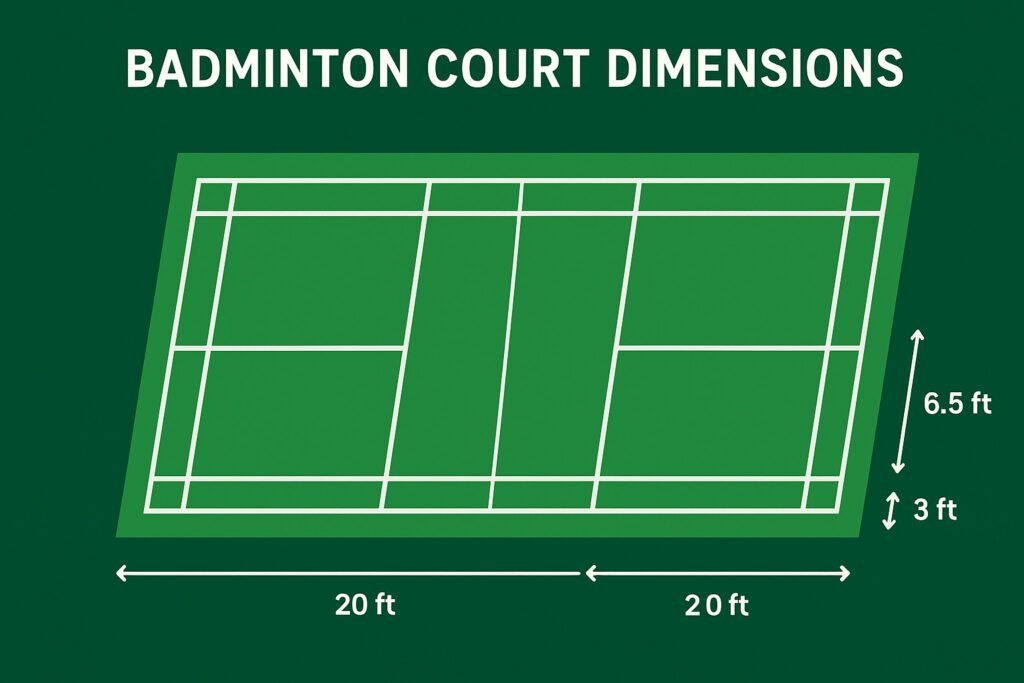Mastering the Court: A Complete Guide to Badminton Court Dimensions
Have you ever watched a professional badminton match and marveled at the players’ speed and precision? The court itself, with its specific lines and zones, is the silent partner in that dance. Understanding Badminton Court Dimensions is fundamental, whether you’re a player looking to improve your strategy, a coach training the next champion, or an enthusiast wanting to set up a court in your backyard. This guide provides a comprehensive breakdown of the official dimensions, explains the key areas of the court, and offers practical tips for proper setup. Let’s dive into the lines and measurements that define the game of badminton. Standard Badminton Court Dimensions Every official badminton court follows a precise set of measurements established by the Badminton World Federation (BWF). These standards ensure that every game, whether played in a local gym or an international arena, is contested on an identical playing field. Understanding these dimensions is the first step to mastering the court. The full court, used for doubles play, measures 13.4 meters (44 feet) long and 6.1 meters (20 feet) wide. This rectangular area forms the complete boundary for the game. For singles matches, the court becomes slightly narrower. While the length remains the same at 13.4 meters, the width is reduced to 5.18 meters (17 feet). Understanding the Lines The lines marked on the court are crucial for gameplay, dictating service areas and boundaries. All lines should be 40mm wide and are typically colored white or yellow for clear visibility against the court surface. Key Areas of the Court Beyond the basic boundary lines, a badminton court is divided into specific areas that are vital to gameplay. Knowing these zones helps players understand positioning, serving rules, and strategy. Service Areas The service areas define where a player must stand when serving and where the shuttlecock must land to be considered a valid serve. These areas differ for singles and doubles matches. The short service line is located 1.98 meters (6.5 feet) from the net and marks the closest point a serve can land. The long service line, used only in doubles, is 0.76 meters (2.5 feet) from the baseline. Net and Net Posts The net is the central obstacle in badminton and must conform to specific height regulations. The top of the net should be 1.55 meters (5 feet 1 inch) high from the court surface at the sidelines and droop slightly to 1.524 meters (5 feet) at the center. The net itself is typically made from a dark-colored cord of a fine, uniform thickness, with a mesh between 15mm and 20mm. It is held taut by two net posts placed on the doubles sidelines. Clearance Space Safety is a priority in a fast-paced sport like badminton. For this reason, it is recommended to have a clear, unobstructed space around the court. A minimum clearance of 2 meters (6.5 feet) around the entire court is advised to allow players to move freely and safely without risk of collision or injury. Indoor vs Outdoor Court Considerations While the official dimensions of a badminton court remain the same, the environment in which it is set up can dramatically change the game. The choice between an indoor and an outdoor court comes with distinct advantages and challenges that affect everything from the playing surface to the flight of the shuttlecock. Indoor Courts: The Professional Standard Professional badminton is played exclusively indoors for good reason. Indoor facilities offer a controlled environment that ensures consistency and fairness in play. Outdoor Courts: Casual and Accessible Fun Outdoor courts offer a more accessible way for people to enjoy badminton, whether in a park, backyard, or at the beach. However, they introduce several variables that players must contend with. Ultimately, while an indoor court provides the ideal conditions for competitive and technical play, an outdoor court is a great option for recreational games. Understanding how these environmental factors impact gameplay allows players to adapt their strategy and enjoy the sport in any setting. Why Court Dimensions Matter The specific measurements of a badminton court are more than just lines on the ground; they are the foundation of the game’s integrity and strategic depth. Standardized dimensions ensure that every match, from a friendly neighborhood game to an Olympic final, is played under the same conditions, guaranteeing a level playing field for all competitors. This consistency is crucial for fair play. A deep understanding of the court’s layout directly influences gameplay strategy. The size and shape of the service boxes, the distance to the net, and the width of the sidelines all dictate a player’s positioning, shot selection, and movement. For example, knowing the exact depth of the court helps players gauge the power needed for a clear shot to land just inside the baseline. Similarly, recognizing the narrower confines of the singles court encourages a game of precision and agility, while the wider doubles court opens up angles and emphasizes teamwork. Players can use their knowledge of the court dimensions to gain a significant advantage. Here are a few tips: Setting Up a Badminton Court Creating your own badminton court can be a rewarding project, whether it’s a temporary setup in your backyard or a more permanent installation. Accuracy is key to ensuring your court meets official standards and provides a fair playing surface. This guide will walk you through the process, from gathering materials to marking the final lines. Tools and Materials Needed Before you begin, gather the right equipment to make the job easier and more precise. You will need: Step-by-Step Marking Guide Common Mistakes to Avoid A small error in measurement can impact gameplay. Watch out for these common pitfalls: Conclusion From the specific height of the net to the exact width of the sidelines, every line on a badminton court has a purpose. Understanding these official dimensions is fundamental to appreciating the game’s strategic depth. We’ve covered the standard measurements for singles and doubles, explored the key areas that dictate play, and contrasted the controlled environment of an




